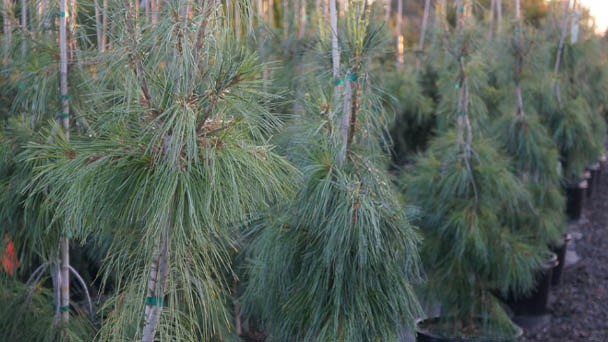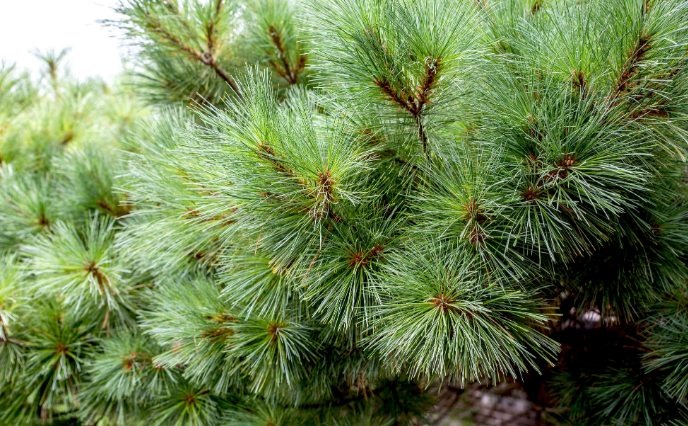What Is A Weeping White Pine - What's the Special
Written by Ivy
Dec 27 2022

Not everyone will like the weeping white pine tree (Pinus strobus 'pendula'), an inclining variety of the eastern white pine. This tree has a distinctive, twisted shape, pine branches that hang down, and lovely blue-green needles. In the middle of a garden lawn, its irregular shape, slow growth, and compact size make it a fascinating specimen tree.
Weeping White Pine Overview
| Botanical Name | Pinus strobus 'pendula' |
| Common Name | Weeping White Pine, Weeping Eastern White Pine |
| Plant Type | Evergreen pine tree |
| Mature Size | Up to 15 feet |
| Sun Exposure | Full sun/partial shade |
| Soil Type | Preference for sandy, loamy, well-drained |
| Soil pH | Preference for acidic but tolerates a variety |
| Bloom Time | n/a |
| Flower Color | n/a |
| Hardiness Zones | 3 to 8 |
| Native Area | North America |
What is a Weeping White Pine?
Weeping white pine (Pinus strubus "Pendula") is a small cultivar of the white pine family. It is a small shrub with numerous stems, according to information on pendula. The branches spread out like a ground cover as they grow downward and downward. Weeping white pine, however, can grow into a small tree up to 12 feet (3.5 meters) tall with proper early pruning.) tall. Its canopy's shape is erratic. The spread of a weeping white pine's canopy can be two to three times that of its height. Smooth trunks with silvery-gray bark cover weeping white pine trees. When the trees are young, their bark is beautiful, but as they get older, the foliage grows down to the ground and completely covers the trunks. The evergreen, pleasant-smelling needles of a weeping white pine are. Between 2 and 4 inches (5-10 cm), they are either blue or blue-green.) long.
How to Grow Weeping White Pine Trees
Your weeping white pine will function best if it is planted in moist, fertile, well-drained, and acidic soil and is situated in a sunny area.
This species prefers cool climates, so a city garden is not a good place for it to grow. The tree may produce fewer branches and shorter, less healthy, or even yellowing needles as a result of excessive urban pollution.
Light
Your weeping white pine can survive in a spot with some shade while it is still growing, but once it has grown to a mature size, it prefers to have lots of sun.
Soil
Most soil types will support the growth of these trees as long as they are moist, fertile, and well-drained. However, they prefer acidic soils over dense, compacted clay and dislike it.
By adding mulch around the tree's base, you can keep the soil moist, keep the roots cool, and lessen the soil's alkalinity. A high pH level in the soil can cause needle chlorosis, which causes the foliage to turn yellow from a lack of chlorophyll.
One excellent mulching material is some of the dropped needles.
Water
White weeping pines prefer to have constant moisture. They will require frequent watering if you live in a region that occasionally experiences drought. But they also won't put up with standing water. Root decay and chlorosis could result from this.

Temperature and Humidity
This tree won't grow well in your garden if you live in a very hot, dry area. They thrive best in cooler climates and are not drought-tolerant species. Additionally, they are unable to endure salinity. They won't grow well in gardens along the coast or in areas that are downhill from heavily gritted roads in the winter. You might notice that the needles lose their blue tones during this time if it is cold throughout the winter.
Fertilizer
Your weeping white pine will benefit from being fertilized in the spring with a highly acidic variety made specifically for evergreen plants.
Pruning
Your weeping white pine needs to be trained from a young age if you don't want it to grow into a sprawling, low, untidy shape. Its single, tall, tapered central leader is what you want to encourage. To get the tree to take on the desired shape, it may take several years of meticulous, structural pruning while it is still young.
Commons Pests/Diseases
Numerous diseases and pests are able to infect weeping white pine. They might appeal to specific aphids, bark beetles, spruce mites, and pine weevils.
Forms of rust and blight are frequently their biggest issues. The most harmful disease, which can kill your tree, is white pine blister rust on the bark.
This fungus causes the needles on the branches to first turn yellow and then a rust-like red. Cankers begin to form on the branches after that and may ooze white sap. In the spring, these cankers can also occasionally release orange spores. To try and stop the spread, infected branches should be cut down.
Weeping White Pine Trees Planting Location
The weeping white pine loves soil that is rich in organic material and will thrive in loam type soils that have a medium level of moisture. You should pick a location that is also well drained to prevent root rot. In hotter climates, young trees will benefit from some partial shade, but as the tree ages and reaches its maximum height, full sun throughout the day is acceptable.
The tree can grow to heights of over 15 feet and diameters of at least 20 feet, so you'll want to place it where it will have plenty of room to expand. As one of the slower growing species it could take up to 20 years for its full size to really show its impressive impact on your garden. Generally speaking, if you want to train a tree of this size to grow more upright, you should avoid planting it too close to any kind of building or under power lines.
History and Origins of the White Weeping Pine
Pinus strobus is a tree that originally came from the eastern part of North America, but it can also be found in the west, all over Canada, and even further south in Georgia. The tree was first introduced in the United Kingdom in 1620 by George Weymouth, an English explorer of the region that is now the state of Maine. The tree is known to the Native American Iroquois nation as the Tree of Peace and is known as the Weymouth Pine there.
Numerous white pine cultivars have been created into novel shapes, including smaller dwarf varieties and those with weeping habits, like the Pendula. A conical-shaped tree with a wide spread, the pendula can grow up to 20 feet in diameter. Because it naturally grows closer to the ground, the weeping white pine is a good choice if you want to cover a sizable area that is barren. At maturity, the tree will grow to a height of at least 15 feet, if you're interested in training it to stand up straight.
Young branches of Pendula typically spread out horizontally before taking on the tree's characteristic drooping appearance. The species has a tall, straight trunk. The branches of the tree become more asymmetrical as it grows older, emphasizing its distinctive form. Its densely covered branches are covered in long, thin, blue to green needles that are softer than the pine needles of other species that you are probably accustomed to. Since the tree is an evergreen, the autumn and winter seasons hardly noticeably alter its appearance.
FAQs
How to Train a Weeping White Pine
Training a weeping pine or other conifer is essential to help the tree develop a central trunk. The way to tackle this task is to cut out any low branches that develop at the trunk while the tree is still young. Make a cut that only leaves a six millimeter (6 mm) border.) stub to safeguard the tree from disease.
What Are Weeping White Pine Diseases
A number of diseases and pests can affect weeping white pine. For some aphids, bark beetles, spruce mites, and pine weevils, they can be attractive. Their biggest problems tend to be forms of rust and blight. The most dangerous disease, which appears as blister rust on the bark of white pine, can cause your tree to die.
What is the Height of Weeping White Pine
Weeping White Pine will grow to be about 12 feet tall at maturity, with a spread of 20 feet. It can be planted under power lines because of its low canopy, which typically clears the ground by 2 feet. It has a slow rate of growth and, in a perfect world, can live up to 50 years.
How to Prune Weeping White Pine
The way to tackle this task is to cut out any low branches that develop at the trunk while the tree is still young. Make the cut so that it only leaves a six millimeter (24 mm) gap.) stub to safeguard the tree from disease. Training a weeping pine should be done during the tree's dormancy, in the winter.
Latest Updated
- Benefits of Bugleweed - 7 Science-backed Health Benefits
- Bugleweed Dangers & Side Effects - Is It Poisonous?
- How to Plant Evergreen Trees - What You Should Know
- When to Plant Evergreens - Grow Guide for Evergreen Trees
- 12 Wonderful Evergreen Shrubs for Your Garden
- 12 Popular Evergreen Plants with Pictures for Beginners
- When And How To Prune A Lilac Bush Like a Pro
- How to Grow & Care for Lilac Vine (Hardenbergia Violacea)
- Japanese Lilac Tree (Syringa Reticulata) Care & Propagation Guide
- Shumard Oak Pros and Cons - What to Know
Popular Articles
- Winter maintenance of Antirrhinum Majus
- How to Grow Terminalia Mantaly Tree
- How to Grow and Care for Crossostephium Chinense
- How to grow Antirrhinum Majus in spring
- Peristeria Elata (Dove Orchid) Profile: Info & Care Guide
- Underwatered Snake Plant (Sansevieria Trifasciata) - Signs And How To Fix
- How to Care for Brazilian Jasmine Plant (Mandevilla Sanderi)
- How to Grow & Care for Graptopetalum Purple Delight in Summer
- Rosa Chinensis (China Rose): Plant Growing & Care Tips
- How to Care for Baby Sun Rose (Aptenia Cordifolia)